[Retracted] Evaluation Analysis and Key Index System Construction of Urban Public Management Service Quality Based on Grey Judgment Method
Abstract
The development of today’s society has entered an era dominated by technology and efficiency, leading enterprises and governments to overemphasize the role of efficiency in the process of rapid development, while ignoring the fundamental goal of social development. The degree of urbanization has increased significantly, but the problems existing in the city are becoming more and more serious, especially the neglect of public services, which has caused great dissatisfaction. This paper firstly compares and synthesizes the performance of several methods to obtain that the grey judgment method is more suitable for this paper; that is, the grey judgment method is used to analyze the evaluation of urban public management service quality and to construct the key index system. The two-level indicators are all in line with the standard after screening the indicators by the method; the first-level indicators have the largest weight in the assess of the quality of urban common management services, and equipment management is considered to be the most important, followed by cultural construction, emergency management, greening management, and sanitation management; among the secondary indicators, the public health portfolio has the largest weight value, with a combined weight of 0.0989, followed by timely maintenance, quality of green vegetation, accident treatment, water and sewage treatment, natural disaster treatment, maintenance quality, garbage disposal, daily maintenance, the quality of cultural facilities, the daily maintenance of greening, and the quality of cultural activities; experts scored the indicators to get the highest score for equipment management, with a score of 0.7799, followed by emergency management, sanitation management, greening management, and cultural construction. By examining the quality of urban public services, it can more respond to the needs of national for public serving, and it can more effectively facilitate the future growth of the town and improve the overall level of community services.
1. Introduction
First, the current situation of the national public transportation network is analyzed, and a multilevel assessment of the public transportation network is proposed based on the complex factors of urban transportation and related literature. A scoring model (AHP) that combines greyscale scoring and AHP processes is then created. Finally, it is used in the actual evaluation of Jinan’s public transportation system and has achieved certain positive effects, which proves the scientificity, reliability, and ease of use of the grey analytic hierarchy process evaluation method [1]. The main purpose is to understand users’ perceptions of the service quality of the urban public transport system and to investigate whether they would use their own private cars as an alternative to transport, such as car sharing and bicycle sharing. In fact, it is critical for cities to review and break car ownership standards to allow citizens to park as an environmentally friendly solution [2]. Passenger satisfaction plays an important role in the choice of transportation modes and directly affects the quality of train services. Establish a train quality index evaluation system based on passenger demand. Take China’s G33 high-speed passenger train as an example. The service quality score can be calculated by a hybrid method based on grey correlation analysis (GCA) and fuzzy composite rating (FCJ). The results show that the indicator system and the integration of GCA and FCJ can well evaluate the traffic quality of passenger trains [3]. The study used primary and secondary data collected by ACBSE over the past 19 months. The results showed that the company’s overall operating and financial performance was inadequate. Among various operating performance indicators, the company operates in accordance with international standards and cannot make up operating costs from traffic revenue. In addition, the company cannot meet future service quality levels and attract more passengers. Therefore, enterprises should design optimal bus schedules and bus schedule systems to meet the needs of passengers as much as possible and minimize operating costs [4]. Using the Balanced Scorecard (BSC) to establish an effective performance benchmark for Taiwan High Speed Rail (HSR) services, then the key factors of Taiwan Grey HSR service quality and the importance of performance benchmarks were identified. Importance-performance analysis (IPA) is used to analyze high-speed rail passengers. Is the quality of service acceptable? The results show that HSR riders are diligent and willing to spend more time to save time; so, pay attention to timing, safety, and comfort. In addition, high-speed rail policies can provide discounts to passengers, thereby increasing passenger satisfaction and loyalty. Therefore, passengers are willing to continue spending, which helps to improve the profitability of high-speed trains [5]. Its purpose is to study and analyze the factors influencing the success and relative failure of new governance programmes (NPM) in developing countries, particularly Singapore and Bangladesh. Key factors such as the advanced level of economic development, the existence of a formal market economy, the rule of law, the advanced level of administrative infrastructure, and the efficiency of the country are the keys to the success of the new public management reform. Singapore largely meets these criteria. Bangladesh is behind this situation and has made little progress on NPM initiatives. The results also show that the government continues to play a greater role in social and economic development, especially in implementing market-oriented reforms [6]. Berry offers four explanations for the factors driving government agencies to adopt strategic planning: their resources, governance cycle, business and civic focus, and the spread of strategic planning across states. Her research shows that agencies are likely to plan strategically: (1) in the early stages of a governor’s administration, (2) when fiscal policy is sound, and (3) when agencies are working closely with private sector companies, as well as in neighboring countries, increased number of agencies introduces strategic planning. According to the research results, there is information on practitioners [7]. Society is the object of public cultural services, and the social satisfaction index is the main indicator for evaluating the effect of public cultural services. The grey relational approach is used to select the most important factors affecting society. In satisfaction with the provision of public culture, the number of public libraries, the number of public cultural activities organized, and the number of practitioners in public cultural institutions are the three most important factors. The article shows a satisfaction model based on the relationship of the grey analytic hierarchy process, uses this method to evaluate the society’s satisfaction with the current public culture, and proposes specific actions to improve and promote my country’s public cultural services [8]. The results suggest that public transport service providers and operators in Belgrade should focus primarily on service reliability and vehicle components to maximize service improvements and meet customer needs. According to the frequency of user opinions, the two main inferior features of Belgrade’s public transport system are regularity and vehicle comfort (vacancy rate). The greatest impact was as follows: 22.0% for relative frequency and 14.0% for staff (drivers), and the relative importance of progress was 13.0% by absolute importance, the most important being the frequency of vehicles-rank 1, employees (drivers)-ranks 2, and above-rank 3 [9]. The study refines this behavioral goal and examines the relationship between passengers’ behavioral intentions and various factors that affect them, as well as what was found in previous research, such as service quality, perceived value, and satisfaction surveys. The study also highlights the role of public transportation in stimulating traveler behavior [10]. Public transportation is one of the most complex systems in a modern city. Based on grey system theory, a relational model for evaluating the grey urban traffic system is proposed. In this regard, the use of public transport in northern cities is a method for evaluating traffic quality [11]. In Nairobi, a special public transport questionnaire was developed and implemented to collect baseline information and data to facilitate analysis, which also provides the variables needed to develop a structural equation model (SEM) to assess the relationship between observed and unobserved variables and their contribution to unobservable characteristics such as overall passenger satisfaction, service quality scores, travel safety and cost, service impact on quality, and declared safety. Travel costs and estimated system performance are a major satisfaction factor [12]. The experimental results confirm that service quality can be conceptualized as application service quality, technical service quality, convenience and cleanliness, service planning, and reliability, and that the positive effect on recycling intention by improving customer satisfaction is customer satisfaction with passenger recycling [13]. In the study, quality of service scale developed for the Taipei city bus system was developed and tested. Churchill’s paradigm and group interviews are combined in a multistep developmental process. That is why the service quality scale was developed with the Taipei public transportation in mind. The final scale consists of four measurements and 20. The four dimensions are “passenger experience,” physical facilities, “ease of use,” and “operation management support” [14]. Mobility, comfort, and satisfaction vary according to the five criteria of the destination. The results show that the time-related service components (train arrival information, current route) are suitable for travelers, education, business, and tourism [15].
2. Urban Public Management Services
2.1. Problems Existing in Urban Public Management
- (1)
The government management functions have not been effectively defined
- (2)
There is a debt management situation in urban construction
- (3)
Law enforcement issues in urban management
- (4)
The problem of economic management means in urban management
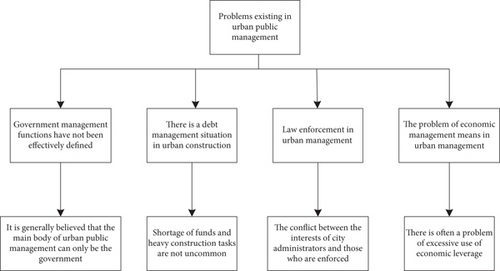
2.2. Standards for Urban Public Service Management
- (1)
It is based on the premise of urban economic construction and development. Urban development must first be reflected in the development of the level of economic construction. Only by forming a relatively mature economic development model can the operation and development of the entire city be supported
- (2)
Focus on the development needs of urban residents. The public service management of urban construction should be based on the actual needs of urban residents. With the continuous improvement of urban construction level, residents have put forward higher requirements for the improvement of urban public service management functions
- (3)
Supported by digital information technology. Urban construction must adapt to the environment of the modern information technology era; so, the use of technology should be emphasized in the management of public services
2.3. Solutions to Optimize Urban Management Services
- (1)
Clarify the responsibilities and consolidate the management responsibilities of the department. It can innovate the concept of scientific urban governance and compact the management responsibilities of various departments
- (2)
Alleviate conflicts and promote standardized and harmonious law enforcement. It can change the concept of urban management law enforcement and strengthen the publicity of urban management law enforcement
- (3)
Improve the quality and participate in urban management by the whole people. It is possible to persist in long-term publicity and mobilization work and cultivate citizens’ awareness of social responsibility
- (4)
Innovative means to promote intelligent urban governance. It can deepen the reform of government services and promote the intelligentization of urban governance

3. Grey Judgment Methods
3.1. Weight Calculation Based on Subjective and Objective Weighting Method
The unclear network analysis method causes decision-makers to be affected by many factors such as the objective environment and cannot give accurate preference information. Therefore, in the classical ANP method, the scale of the structural proposition matrix is converted into a triangular fuzzy number and surrounds it. Express the preference value of the decision-maker. Therefore, triangular fuzzy numbers are introduced into ANP to make full use of the advantages of triangular fuzzy numbers in dealing with ambiguity and improve the accuracy of information processing. In this paper, a fuzzy network analysis method based on a comparative scoring matrix is used to determine the weight of attributes. The first step of the approach is to transform the problem into a hierarchy; Hfirst uses fuzzy AHP to obtain independent attribute weights and then uses the fuzzy network analysis method to obtain global weights. Assuming that the first-level attribute in the network model is represented by K, and the second-level index is represented by KL, the steps for calculating the global weight of the attribute index are as follows:
According to the opinions and language terms of three different groups of decision-makers, an aggregated scoring matrix of first-level attributes is constructed, the opinions of decision-makers are transformed into triangular fuzzy numbers, and the three opinion groups are compared with the average scoring matrix.
In the formula, WI = {ωi1, ωi2, ⋯, ωiK} is the dependency weight vector, and ωiL (L = 1, 2, …, K) represents the dependency weight under the indicator L.
WI = {ωi1, ωi2, ⋯, ωiK} is the interdependence weight vector, and ωiL (L = 1, 2, …, K) represents the interdependence weight under the L-th indicator.
The basic idea of the entropy weight method is to determine the weight of each indicator according to the difference between indicators. When the information entropy of an index is smaller, it means that the degree of variation of the index is greater, the more information contained in the evaluation process, the greater the effect, and the greater the corresponding weight; otherwise, it is smaller:
Equation (10) is an expression of information entropy.
where ωj is the total weight of j. β is the weight coordination factor; 1 − β is the subjective weight ratio. This paper assumes that the ratio of subjective weight and objective weight is equal; that is, β = 1 − β = 0.5, and the final weight can be as follows:
3.2. Grey Weighted Relational Synthesis Model
represents the maximum value of the j attribute.
By determining the overall advantage of each alternative, prioritization of alternatives can be achieved, and the higher the value of Si, the better the alternatives.
The higher the value of Si, the better the alternative; the lower the value of A, the worse the alternative.
4. Grey Judgment Method in Urban Public Management Service Quality Evaluation Analysis and Key Index Construction System
4.1. Construction System of Key Indicators of Urban Public Management Service Quality
To build a key indicator system for the quality of urban public management services, first, the key indicators of urban public management service quality are divided into two parts. The first-level indicators are divided into five aspects: equipment management, sanitation management, greening management, cultural construction, and emergency management. There are 12 indicators in total, which are distributed as daily maintenance, timely maintenance, maintenance quality, garbage disposal, water and sewage disposal, public health, greening routine maintenance, greening vegetation quality, cultural activity quality, cultural facility quality, accident handling, and natural disaster handling, and 12 impact factors were assigned and calculated to form a quantitative evaluation index, as shown in Table 1 below.
| First-level indicator | Secondary indicators |
|---|---|
| Device management | Routine maintenance |
| Timely maintenance | |
| Maintenance quality | |
| Hygiene management | Garbage disposal |
| Sewage treatment | |
| Public health | |
| Green management | Greening routine maintenance |
| Green vegetation quality | |
| Cultural construction | Quality of cultural activities |
| Quality of cultural facilities | |
| Emergency management | Accident handling |
| Natural disaster management |
4.2. Indicator Screening and Determination
A total of 10 experts participated in the screening work. A total of 10 consultation forms were distributed, 10 were recovered, and 10 were valid. The effective recovery rate was 100%. By calculating the first-level indicators, it can be found that the mean worth is 0.549, the standard deviation is 0.125, and the threshold worth is 0.423. The full-point rate k of the first-level indicators is compared with the threshold value, and the full-point rate k of equipment management is 0.782, which meets the threshold value standard. The full score k of management is 0.564, which meets the threshold standard; the full score k of greening management is 0.443, which meets the threshold standard; the full score k of cultural construction is 0.442, which meets the threshold standard; the full score k of emergency management is 0.512, which meets the threshold criteria, as shown in Table 2 below.
| First-level indicator | Full score k |
|---|---|
| Device management | 0.782 |
| Hygiene management | 0.564 |
| Green management | 0.443 |
| Cultural construction | 0.442 |
| Emergency management | 0.512 |
| Mean | 0.549 |
| Standard deviation | 0.125 |
| Threshold | 0.423 |
It can be found out in Figure 3 that the first-grade index is calculated to obtain a mean value c of 4.304 and a coefficient of variation v of 0.158. The mean value c of the first-level index and the coefficient of variation v are compared with their corresponding thresholds to obtain the mean value of the equipment management c is 4.782, and the coefficient of variation v is 0.087, which all meet the threshold standard; the mean value c of hygiene management is 4.561, and the coefficient of variation v is 0.109, which both meet the threshold standard; the mean value c of green management is 4.334, and the coefficient of variation v is 0.154, which both meet the threshold standard; the mean value c of cultural construction is 4.332, and the coefficient of variation v is 0.154, which all meet the threshold value standard; the mean value c of emergency management is 4.381, and the coefficient of variation v is 0.149, all of which meet the threshold value standard, as shown in Figure 3.
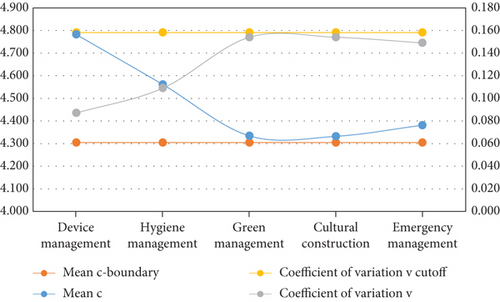
It can be found out in Table 3 that the mean value of the secondary index is 0.43, the standard deviation is 0.24, and the brimming score rate k is 0.19. The full score ratio k of the secondary indicators is compared with its corresponding boundary value to obtain the daily maintenance full score ratio k that is 0.4, which meets the threshold standard; the full score k for maintenance timely is 0.4, which meets the threshold standard; the full score for maintenance quality k is 0.4, which meets the threshold standard; the full score ratio k for garbage disposal is 0.2, which meets the threshold standard. The ratio k is 0.9, which meets the threshold standard; the full score ratio k for public health is 0.5, which meets the threshold standard; the full score ratio k for daily greening maintenance is 0.3, which meets the threshold standard; the full score ratio k for green vegetation quality is 0.2, which meets the threshold standard. The full score k of cultural activity quality is 0.6, which meets the threshold standard; the full score k of accident handling is 0.2, which meets the threshold standard; the full score k of natural disaster handling is 0.2, which meets the threshold standard, as shown in Table 3.
| Secondary indicators | Full score k |
|---|---|
| Routine maintenance | 0.4 |
| Timely maintenance | 0.4 |
| Maintenance quality | 0.4 |
| Garbage disposal | 0.2 |
| Sewage treatment | 0.9 |
| Public health | 0.5 |
| Greening routine maintenance | 0.3 |
| Green vegetation quality | 0.2 |
| Quality of cultural activities | 0.6 |
| Quality of cultural facilities | 0.9 |
| Accident handling | 0.2 |
| Natural disaster management | 0.2 |
| Mean | 0.43 |
| Standard deviation | 0.24 |
| Threshold | 0.19 |
It can be found out in Figure 4 that the mean worth c is 3.79, and the coefficient of variation v is 0.184. The mean value c and the coefficient of variation v of the secondary indicators are compared with their corresponding thresholds to obtain the daily maintenance mean value c that is 3.97, and the coefficient of variation v is 0.171, which all meet the threshold standard; the mean c of maintenance timely is 3.99, and the coefficient of variation v is 0.181, which all meet the threshold standard; the mean c of maintenance quality is 3.8, and the coefficient of variation v is 0.171, which all meet the threshold standard; the mean value c of garbage treatment is 3.8, and the coefficient of variation v is 0.18, which all meet the threshold standard; the mean value c of sewage treatment is 4, and the coefficient of variation v is 0.178, which all meet the threshold value standard; the mean value c of public health is 3.9, and the coefficient of variationvis 0.178, which all meet the threshold standard; greening routine maintenance mean c is 3.86, and the coefficient of variation v is 0.143, which all meet the threshold standard; green vegetation quality mean c is 4.1, and the coefficient of variation v is 0.173, which all meet the threshold standard. The mean value c of cultural activity quality was 4.5, and the coefficient of variation v was 0.167, all meeting the cut-off standard; the mean value c of cultural facilities quality was 4.5, and the coefficient of variation v was 0.181, all meeting the cut-off standard; the mean value c of public health was 3.9, and the coefficient of variation v was 0.181. The mean value c of accident treatment was 3.98, and the coefficient of variation v was 0.181, which all met the threshold value standard; the mean value of natural disaster treatment was 3.85, and the coefficient of variation v was 0.181, all of which met the threshold value standard, as shown in Figure 4.
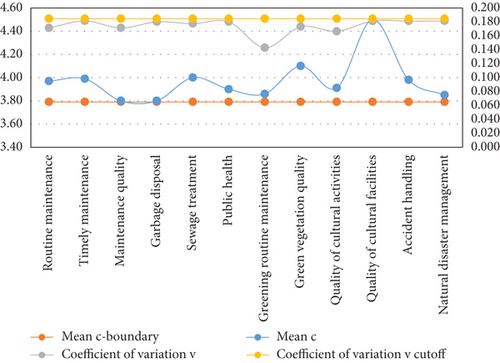
After summarizing the expert scores, calculate the arithmetic mean, brimming score rate, and modulus of variety of each indicator. In this way, each indicator has three judgment scales. In order to avoid the exclusion of important indicators, the exclusion criteria of the specially set indicators are as follows: any indicators with more than two judgment scales that do not meet the threshold standard will be excluded. From Tables 2 and 3 and Figures 3 and 4, it can be judged that the first and second-level indicators do not meet the set index exclusion criteria; so, both the first and second-level indicators are retained.
4.3. Evaluation and Analysis of Urban Public Management Service Quality
According to the data in Figure 5, we can see that after running on the test set, the accuracy of the evaluation and analysis of urban public management service quality under the grey judgment method reaches 95.60%, the feasibility reaches 94.23%, the reliability reaches 96.61%, and the authenticity reaches 95.60%. 95.66% is the one with the highest index of the four methods combined. The analysis accuracy of urban public service quality evaluation under the structural equation method is 85.34%, the feasibility is 88.66%, the reliability is 89.12%, and the authenticity is 87.67%, which is the lowest comprehensive index among the four methods. We can also see that the curve value of the urban public management service quality evaluation analysis under the grey judgment method is also more stable than others, indicating that the performance of the grey judgment method is optimal, as shown in Figure 5.
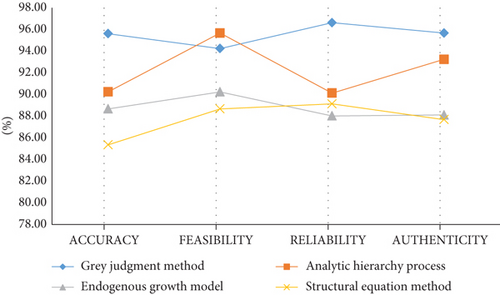
According to the statistics of the data, the total number of device management was obtained. Expert 1 scored 2.5 for the first-level index equipment management, 1.5 for hygiene management, 1 for greening management, 2.5 for cultural construction, and 2.5 for emergency management. Expert 2 scored 2.5 points for device management, 1.5 points for hygiene management, 1.5 points for greening management, 1.5 for cultural construction, and 3 points for emergency management. Expert 3 scored 2 for device management, 1.5 for hygiene management, 2.5 for greening management, 2.5 for cultural construction, and 1.5 for emergency management. Expert 4 scored 2 for device management, 2.2 for hygiene management, 2.1 for greening management, 2.2 for cultural construction, and 1.5 for emergency management, as shown in Table 4 and Figure 6 below.
| Serial number | Device management | Hygiene management | Green management | Cultural construction | Emergency management |
|---|---|---|---|---|---|
| Expert 1 | 2.5 | 1.5 | 1 | 2.5 | 2.5 |
| Expert 2 | 2.5 | 1.5 | 1.5 | 1.5 | 3 |
| Expert 3 | 2 | 1.5 | 2.5 | 2.5 | 1.5 |
| Expert 4 | 2 | 2.2 | 2.1 | 2.2 | 1.5 |
| Total | 9 | 6.7 | 7.1 | 8.7 | 8.5 |
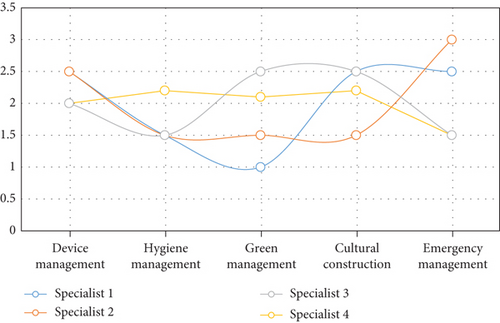
The higher the value of the grey judgment method, the better the effect of executing the replacement scheme; on the contrary, it means that the worse the effect of executing the replacement scheme. Choosing the appropriate grey judgment value is the key to show good performance. Therefore, it is very critical to choose the appropriate grey judgment value through scene application.
It can be found that the equipment management has maximum weight, and it is considered to be the most important, followed by cultural construction, emergency management, greening management, and sanitation management, as shown in Table 5.
| Index | Index weight |
|---|---|
| Device management | 0.225 |
| Hygiene management | 0.1675 |
| Green management | 0.1775 |
| Cultural construction | 0.2175 |
| Emergency management | 0.2125 |
In equipment management, timely maintenance has maximum weight with a weight of 0.245, secondly maintenance quality and daily maintenance; in sanitation management, water and sewage treatment has the largest weight with a weight of 0.354, followed by public management and garbage disposal; in greening management, the weight of greening vegetation quality is the largest, with a weight of 0.548, and the weight of daily green maintenance is 0.452; in cultural construction, the weight of cultural facilities quality is 0.577, and the weight of cultural activity quality is 0.423; in emergency management, accident handling has the largest weight, with a weight of 0.512, secondly natural disaster handling with a weight of 0.488. Among the second index, the combined weight of public health is the largest, with a combined weight of 0.0989, followed by timely maintenance, quality of green vegetation, accident handling, water and sewage treatment, natural disaster treatment, maintenance quality, garbage disposal, daily maintenance, cultural facility quality, daily maintenance of greening, and quality of cultural activities, as shown in Figure 7 below.
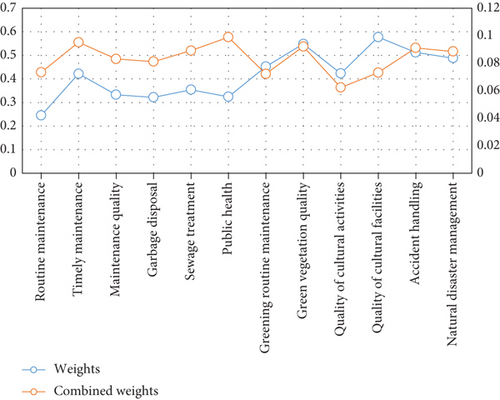
The discreteness of itself, without taking into account the experience of decision-makers, etc., is too objective; in general, the comprehensive weight obtained by combining subjective and objective weights makes the weight of indicators more moderate and not only considering decision-makers. Therefore, when evaluating the quality of urban public management services, in order to make the decision-making results more reasonable and authentic, the comprehensive weighting method is selected as much as possible to determine the weight of the indicators, as shown in Figure 8 below.
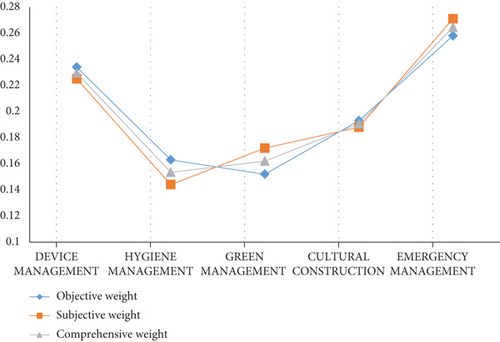
According to the distribution of different weights in Figure 8, the conclusions obtained under different weights have little difference, which shows that the corresponding judgments are consistent. Among the corresponding indicators, the weight of health indicators and greening management is relatively small, showing that the subjective weight and objective weight are only 0.145 and 0.15, respectively. The highest weight values are equipment management and emergency management, and their corresponding subjective weight values are 0.27, and objective weight values are 0.238, which shows that equipment management and emergency management are relatively important and play an obvious key role in actual management.
From the bar chart in Figure 9, it can be seen that the evaluation score of equipment management is the highest with a score of 0.7799, followed by emergency management with a score of 0.7168, hygiene management with a score of 0.6929, greening management with a score of 0.6827, and cultural construction with a score of 0.4728; expert 1 scored the highest on emergency management, followed by sanitation management, equipment management, greening management, and cultural construction; expert 2 scored the highest on equipment management, followed by emergency management, sanitation management, greening management, and cultural construction; experts 3 pairs equipment management that scored the highest, followed by hygiene management, emergency management, greening management, and cultural construction; experts 4 scored the highest in greening management, followed by equipment management, emergency management, hygiene management, and cultural construction.
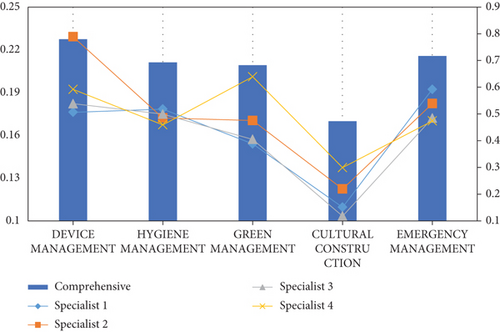
5. Conclusion
Public administrations are advised to regularly upgrade public health facilities and repair damaged litter boxes. The cleaning work implements the postevent responsibility system, and the cleaning personnel are full-time and have clear responsibilities. Establish a cleaning manager to regularly check the quality of cleaning and keep an inspection log. If there is a safety hazard or nuisance during cleaning, clear signs should be posted, and necessary protective measures should be taken. The municipal government is the core of the cooperation mechanism and promotes the cooperation mechanism. On the cooperation platform, the municipal public administration department should take punctuality, efficiency, and publicity as its own responsibility, continuously strengthen the response to the needs of the community, establish a community for expressing demands, put forward opinions and supervise the government, and provide uninterrupted feedback channels. In the collaborative platform, all the original public and market economic entities’ complaint acceptance channels have been opened up, and various approval and service resources have been centrally integrated to make the channels more well known, popular, and convenient. Urban green space management should pay attention to maintenance and economic work such as irrigation and fertilization of live plants. Through the continuous and uninterrupted maintenance of vegetation, the ecological value, landscape value, and humanistic value of the impact of landscaping on the existing greening environment can be enhanced to ensure that the role of landscaping can be maximized. The key is to properly maintain the green space.
Conflicts of Interest
The author declares no conflicts of interest regarding this work.
Open Research
Data Availability
The experimental data used to support the findings of this study are available from the corresponding author upon request.




